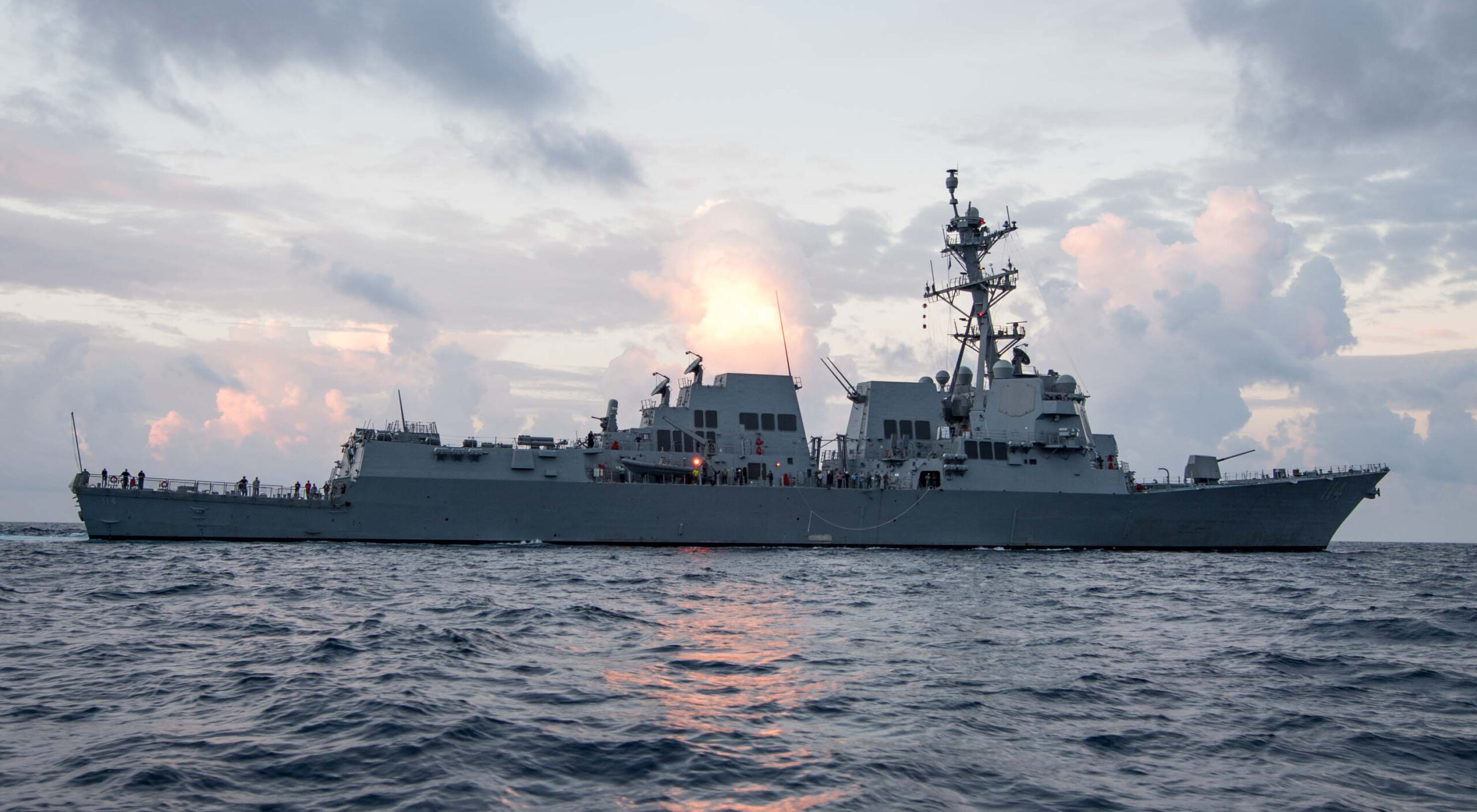Civilization
To Defend Taiwan, the U.S. Navy Must Retake the Ocean High Ground
A retired admiral says the U.S. Navy must retake the ocean high ground, and recommends a specific program to that end.

A well-known axiom in warfare is that occupying elevated terrain, or high ground, provides a tactical advantage over an opposing force.
There is a form of high ground in the undersea domain as well. Bathymetric and sedimentary features of the seafloor, as well as dynamical changes in the three-dimensional distribution of seawater properties over time affect the performance of the undersea acoustic and optical sensors used to detect and target an adversary’s assets. Depending upon the impact of these variations on the propagation of sound and light, it may be more beneficial to operate in different regions of the ocean than others, much like the way cloud free skies enable the collection of imagery with reconnaissance satellites.
The U.S. Navy maps and monitors this ever-evolving ocean high ground with a fleet of oceanographic ships, an array of underwater drones, an interagency constellation of environmental satellites, as well as a global network of fixed and drifting sensors on the seabed, the sea surface and within the water column. The primary challenge for these systems is that the global ocean is vast, and large volumes of the maritime domain are unobserved. In fact, we know more about the surfaces of Mars and the moon than we do about the world’s seafloor, of which 75% has not been mapped to modern standards. This tragically came to light in 2005 and 2021 when two U.S. submarines collided with uncharted seamounts.
Compounding the problem is the fact that China has dramatically increased its oceanographic surveying activities in the Indo-Pacific region. A recent report by the Center for Strategic and International Studies (CSIS) revealed that Chinese survey vessels have carried out hundreds of thousands of hours of operations over the past four years. Incredibly, the People’s Republic of China (PRC) has 64 active research and survey vessels compared to the 11 operated by the Naval Oceanographic Office and the University National Oceanographic Laboratory System for the U.S. Navy. Unfortunately, this disparity only mirrors the rapid expansion of the Chinese People’s Liberation Army Navy into the largest navy in the world.
The U.S. Navy’s relinquishing of oceanographic leadership to China is not just an academic concern, as an accurate understanding of the ocean environment is an essential enabler in submarine operations, mine warfare, amphibious warfare and Naval Special Warfare — all of which may be necessary for a successful defense of Taiwan.
To right this ship of ocean science superiority, the U.S. Navy needs to take the following action now:
Increase the scope and funding for the Navy’s Task Force Ocean (TFO)
In 2017, as oceanographer of the Navy, I established TFO with the Office of Naval Research to advance Navy-relevant ocean science through strengthened partnerships with academia and the private sector. A priority effort for TFO today is a four-year Department Research Initiative to conduct a detailed study of ocean processes in a 10,000 square kilometer area off the U.S. East Coast. While we will learn a great deal from this research, the time is now to conduct similar studies in the South China Sea, East China Sea, and Philippine Sea, which is the area of operation for any foreseeable fight with the PRC.
Assign NOAA Ships to more Indo-Pacific missions in the U.S. Exclusive Economic Zone (EEZ)
The National Oceanic and Atmospheric Administration (NOAA) has a fleet of 16 oceanographic ships which conduct fisheries and hydrographic surveys for the U.S. Department of Commerce. From 2022-2023, the NOAA Ship Rainier completed a first-of-its-kind nautical charting and coral reef survey campaign in the Marianas Islands, American Samoa and the Pacific Remote Island Areas.
To keep the U.S. from falling further behind China, the Navy must build on its current partnership with NOAA by requesting the agency continue campaigns like Rainier’s in the Indo-Pacific.
Leverage the DoD’s Replicator initiative to dramatically expand the Navy’s oceanographic drone fleet
In 2023, the Department of Defense (DoD) announced the Replicator initiative to counter the PRC’s military mass by fielding thousands of attritable, all-domain, autonomous systems. Replicator presents the perfect opportunity for the Navy to overcome its survey ship shortfall by converting them into motherships of unmanned hydrographic vessels in the same way NOAA is doing with the agency’s fleet modernization. Additionally, the Navy needs to increase the quantity and quality of its oceanographic underwater drone fleet with more modular and modern ocean gliders that are on the leading edge of marine technology.
Acquire more commercial data to improve the Navy’s predictive ocean models
One of the most important applications of survey data is to provide boundary and initial conditions for predictive oceanographic models, which are increasingly advancing through the application of data-driven artificial intelligence (AI). To realize the full potential of AI, the Navy needs to access the new wave of commercial ocean data providers who are using small satellite constellations, ocean buoy networks and contractor-owned/contractor-operated ocean drone services. Such cost-effective solutions will also directly address the Navy’s gaps in ocean observations.
Last year, in a series of war games involving the U.S. and China over Taiwan, CSIS found that even in victory, the U.S. fleet could lose over one-quarter of its submarines and a thousand of its sailors. The loss of just a single submarine or sailor is one too many, so it is imperative for us to secure any advantage available. Retaking the ocean high ground can deliver that edge, without which the Navy could be dead in the water.
This article was originally published by RealClearDefense and made available via RealClearWire.
Rear Admiral Tim Gallaudet, U.S. Navy ret., is the CEO of Ocean STL Consulting, LLC, former acting and deputy administrator at the National Oceanic and Atmospheric Administration (NOAA), as well as former acting undersecretary and assistant secretary of Commerce. Prior to NOAA, he served as an oceanographer in the U.S. Navy, completing his career as the commander of the Navy Meteorology and Oceanography Command and founding director of the Navy’s Task Force Ocean.
-

 Civilization3 days ago
Civilization3 days agoDC Pipe Bomb Arrest Raises Questions About Christopher’s Wray’s FBI
-

 Civilization4 days ago
Civilization4 days agoThe Legal Logic Behind U.S. Operations Against Narco-Terrorist Networks
-

 Executive4 days ago
Executive4 days agoNewsom’s ‘National Model’ for Homeless Wracked by Fraud
-

 Executive3 days ago
Executive3 days agoWhen You’re in a Hole, Stop Digging
-

 Education3 days ago
Education3 days agoWaste of the Day: Taxpayers Subsidize Football Coach Severance
-

 Executive2 days ago
Executive2 days agoWaste of the Day: Obamacare Failed Test, Approved Fraudulent Subsidies
-

 Civilization2 days ago
Civilization2 days agoPence Calls on Trump To Fire RFK Jr Over Abortion Drug
-

 Executive4 days ago
Executive4 days agoWaste of the Day: Feds Pay Nonprofits That Sue the Government














